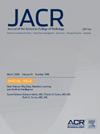深静脉血栓超声检查与非检查因素的相关性分析。
IF 5.1
3区 医学
Q1 RADIOLOGY, NUCLEAR MEDICINE & MEDICAL IMAGING
引用次数: 0
摘要
原理和目的:超声(US)是诊断深静脉血栓形成(DVT)的一线影像。虽然Well的标准和实验室测试有助于提供最佳的订购实践,但本调查评估了各种患者和非患者因素对检查结果的影响。材料和方法:本研究分析了两家机构2015-2022年所有住院和急诊科(ED)超声检查的结构化报告。比较检查、提供者和患者因素对检查结果的影响和组间方差。结果:急性/新发非小腿深静脉血栓总发生率为10.4%。急性/新发非小腿DVT发生率在住院患者(与ED患者相比)、上肢患者(与下肢患者相比)、较低bmi患者、内科医生(与高级执业医师相比)以及由总体DVT US检查较少的医生开具的诊断书中较高。在检查肢体数量和提供者监督情况方面观察到不同的结果。考试日期和考试时间无显著性差异。结论:DVT US结果根据检查、设施、患者和提供者水平的因素而变化,这可以为机构质量监测计划、资源利用以及可能影响诊断测试结果的因素的未来调查提供信息。本文章由计算机程序翻译,如有差异,请以英文原文为准。
Correlation of Examination and Nonexamination Factors With Ultrasound Positivity for Deep Vein Thrombosis
Purpose
First-line imaging for diagnosis of deep vein thrombosis (DVT) is ultrasound. Although the Wells criteria and laboratory testing help inform best ordering practices, this investigation evaluates the influence of various patient and nonpatient factors on examination results.
Methods
The authors analyzed structured reports from all inpatient and emergency department ultrasound examinations across two institutions from 2015 to 2022. Examination, provider, and patient factors were compared with examination results for effect on examination results and intergroup variance.
Results
The overall rate of acute or new noncalf DVT was 10.4%. Rates of acute or new noncalf DVT were found to be higher in inpatients (versus emergency department patients), in upper extremities (versus lower extremities), in patients with lower body mass index values, among physicians (versus advanced practice providers), and when examinations were ordered by providers with fewer overall DVT ultrasound examinations ordered. Mixed results were observed for number of limbs examined and provider supervision status. Examination day of week and time of day were not significant.
Conclusions
DVT ultrasound results varied according to examination-, facility-, patient-, and provider-level factors, which can inform institutional quality monitoring programs, resource utilization, and future investigations into factors that may influence diagnostic testing results.
求助全文
通过发布文献求助,成功后即可免费获取论文全文。
去求助
来源期刊

Journal of the American College of Radiology
RADIOLOGY, NUCLEAR MEDICINE & MEDICAL IMAGING-
CiteScore
6.30
自引率
8.90%
发文量
312
审稿时长
34 days
期刊介绍:
The official journal of the American College of Radiology, JACR informs its readers of timely, pertinent, and important topics affecting the practice of diagnostic radiologists, interventional radiologists, medical physicists, and radiation oncologists. In so doing, JACR improves their practices and helps optimize their role in the health care system. By providing a forum for informative, well-written articles on health policy, clinical practice, practice management, data science, and education, JACR engages readers in a dialogue that ultimately benefits patient care.
 求助内容:
求助内容: 应助结果提醒方式:
应助结果提醒方式:


